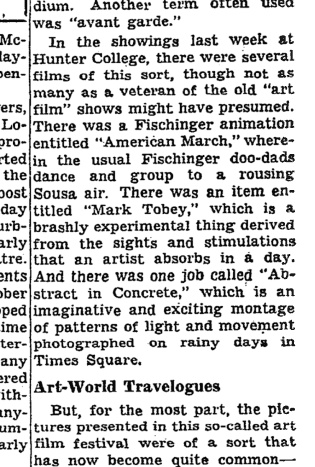Nayland Blake just posted this on his always eye-opening tumblr Knee-deep in the Flooded Victory. Abstract in Concrete is a 10-minute short film by John Aravonio, which pairs reflections of neon signs in the rain puddles of Times Square with a jazz/classical score by Frank Fields. The date given on this recent YouTube upload is 1954. And it is credited to the United States Information Agency.
Which is just nuts.
I watched this film and tried to imagine the time where a government agency with an active agenda to use cultural programming as public diplomacy and international propaganda would produce an abstract exercise like this. It does have a lot of red, white, and blue, I thought. Abstraction is the perfect vessel, it turns out, for delivering the message of Freedom, Enterprise, and The American Way, as seen in the dazzling advertisements at the center of New York City.
But still, this is only a year after the founding of the USIA, and years before the pavilion-based media experiments of the Eameses in Moscow, or ultimately, the World’s Fair in Montreal. Art-wise, Abstract in Concrete seems like a mix of AbEx and Pop that was almost a decade ahead of Pop itself. We know AbEx was the US’s, and/or the CIA’s, Official Export Style; did this extend to experimental abstract short films, too?
So I looked into it a bit, and initially came up with almost nothing about the filmmaker, John Arvonio, besides a mention in Sheldon Renan’s 1967 Introduction to The American Underground Film. It’s one of the “city symphonies” namechecked in a section about “pattern films” that also included the Eameses’ 1950 short, Blacktop, about puddles and reflections on a playground being cleaned. [Many of the Eameses’ films, Renan notes, were “commissioned by organizations like Henry Miller Furniture and IBM,” which nicely captures the paradox of “The Avant-Garde/Experimental/Underground Film” that started this archive dive.]
Then I found a listing for Abstract in Concrete at the International Edinburgh Film Festival in 1952. And a shoutout for winning first prize at the Venice Film Festival the same year. The 1953 UC Quarterly of Film Radio & Television calls Arvonio’s Abstract in Concrete one of those “Hans Richter or Fernand Leger-type of films” for which the terms “avant-garde” and “experimental” were created. It also notes the inclusion of the film in the Second International Art Film Festival, which was held over a weekend in November 1952 at Hunter College.
The IAFF was sponsored by the American Federation for the Arts and CAA, and had moved into town from Woodstock, where the first festival had been a surprise success. The Times’ wrap-up of the festival is pretty great, where the “usual [Oskar] Fischinger doo-dads dance and group to a sousing Sousa air,” and “one job called ‘Abstract in Concrete'” was called “an imaginative and exciting montage of patterns of light and movement.”

I would say this was Abstract and Concrete‘s American premiere, except there was a Nov 14, 1953 article with an unexpected headline, “Frank Fields’ Music in Prize-Winning Film,”. Arnovio had been shooting footage for what became Abstract in Concrete over five years of rainy nights in Times Square. Which would put the start of filming nearer to the end of World War II. And after that war, who wouldn’t want to walk the streets of Manhattan alone at night, staring into puddles? Fields met Arnovio at a screening party for the scoreless work-in-progress in 1951, and he offered the filmmaker a movement from a 1931 composition, the aptly titled “Times Square Silhouette.”
The film’s success jumpstarted Fields’ career, which had been a decades-long series of promise and frustration. The best/worst was when Fields won a composition contest for the 1939 World’s Fair in New York that included the chance to conduct an orchestra playing his piece. Except when he arrived to accept his prize, and they found out he was black [didn’t see that coming did you? The article above turns out to be from The New York Age, a major black paper.], they showed him the door. Fields went on to compose shows for Pearl Bailey, and the score to “The Shoemaker and the Peddler,” a 1960 play about Sacco & Vanzetti. He died in 1969.
For his part, Arnovio never seems to have released another film. In 1952 he was described as a freelance camera operator moving into audio, and his Photo-Magnetic Sound Studios became a prominent fixture in New York’s film, advertising, and media landscape. Abstract in Concrete did about as well as an abstract short film would be expected to do, appearing on film programs fairly regularly in New York through the 1960s, and entering various circulating libraries and into educational distribution. I suspect that this is how it got tagged with the USIA label, by getting programmed into a touring collection of American films.
And so I’ll gladly trade a US-government-backed avant-garde for a scrappier, more complicated, and ultimately more interesting film scene that extends experimental abstraction beyond the usual Fischinger doo-dads.
